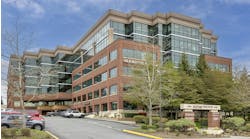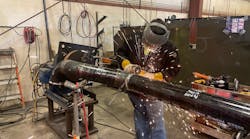Latest from Book of Giants
Sponsored
Their origins are very similar. Haberberger, Inc., began in 1948 in St. Louis, MO, with its founder, Frank Haberberger as a refrigeration service company. AZCO began just one year later, in Appleton, WI, in 1949, with four individuals who saw a need for quality mechanical contractors in central Wisconsin as the post-war boom was getting under way.
From its refrigeration shop beginnings, Haberberger transitioned to commercial refrigeration and, by 1961, began offering air conditioning services and commercial piping construction. Today it is consistently ranked among the top 10 mechanical contractors in the St. Louis area—with 200 employees and $71.4 million in revenue in 2022 alone. And it is still, four generations later, owned and run by the Haberberger family.
AZCO, while still headquartered in Appleton, is today a nationwide provider of heavy industrial construction and prefabrication services. As a wholly-owned subsidiary of Burns & McDonnell, the company is 100% employee-owned with over 1,500 experienced union craft workers across the country and an annual revenue of $360
million.
Both companies paved the road to success with a commitment to quality, a focus on workplace safety, and a relentless drive to innovate and diversify their service offerings. Yet their stories are as different as the industry they exemplify—and as diverse as the customers they serve.
Haberberger, Inc.
Today, Steve Haberberger, Jr., is the current President CEO of Haberberger, and he looks with great pride on all his family and the Haberberger team has been able to accomplish. "We’re in the infant stages of planning a 75th anniversary party," Haberberger said. "We’ll have retirees, clients, probably some suppliers and current employees all gathered up."
The company has seen great success in recent years, mainly due to the growth of the St. Louis area and the high demand for the company's expertise. "We’ve been very fortunate the last couple of years as more of the industrial work has come to us here in St. Louis, and we'll be riding the wave for as long as it lasts," Haberberger said. "Do we think it’s going to stay for another 5 to 10 years? Aside from water/wastewater? Only time will tell. We’ll try to make the most of it while we have it."
The Next Generation Workforce
"We are signatories to UA local 562 and Sheet Metal Workers Local 36, and we’ve been doing a lot of work with them trying to get more people into the manpower pipeline," Haberberger said. "There’s been a couple special projects, specifically, Local 562 UA has its Champions program to work towards a more diverse workplace that includes more women in the trades. That’s been an untapped market."
Haberberger notes that, with the way construction projects are handled now, Project Managers have a lot more on their plates than they did a decade ago. Some of the company's most experienced PMs, however, are approaching the age of retirement, and when they leave a huge amount of institutional knowledge leaves with them.
Haberberger's solution has been to have more junior Project Engineers work under the guidance of more senior Project Managers performing some daily tasks such as submittals, RFIs and plan updates. Part of this is to help PMs make better us of their time, but also they hope those engineers benefit from those decades of experience while they still can.
"We’re hoping that, through osmosis, there’s that transfer of knowledge and experience," Haberberger said, "about some of the difficult conversations you sometimes have to have on a project—with an owner, with people in the field, with fellow contractors, with coordination. Just to learn the ropes with someone who has been doing it for 30 years, see how they react in certain situations. It really helps to build the confidence of that younger generation."
The Prefab Puzzle
"We keep a steady crew of 10 to 15 pipefitters in that fabrication shop," Haberberger said, "so that one is a well-oiled machine. About two years ago we opened up a new sheet metal fabrication facility. We have two coil lines, one for straight duct, one for fittings, and that’s really helped us to be more competitive in the market."
And the work the shop does is not exclusively for Haberberger's own construction work. The company has been able to sell its prefabrication services to clients around the country. "That’s really helped us out," Haberberger said. "That helps them, where they might not have, 10 guys, say, to install all this duct work, we can do long runs for them and maybe then they only need five or six."
Looking to the Future
Since recently completing its sheet metal shop, Haberberger is content with its current facilities. Now the company is turning to invest in new technologies, particularly VDC (Virtual Design and Construction). The company has been using STRATUS, an MEP construction solution that centralizes and streamlines all the data on a project. There has even been discussion of bringing a programmer in-house to help the company's various systems better communicate with each other.
The company's other big project is to reinforce its plumbing division, which was started back in 2016. "We’ve seen rapid growth within that division," Haberberger said. "Plumbing is something that’s always going to be there. Any kind of building you’re building. So we’re trying to build up a great workforce there and make sure we’re staying on the leading edge. Making sure that when people need plumbing we’re the ones that they come to."
And, if a recession does hit, to have built the company to the point where it can weather the storm. "We’ll try to build in our efficiencies, so that if there is a downturn we can fill in other gaps," Haberberger said.
AZCO
Made for Infrastructure
AZCO sees itself as uniquely well-positioned to benefit from the historic levels of infrastructure investment that are in the offing.
"We made our name building infrastructure in the power, pulp and paper, oil and gas and industrial spaces to the point where we’ve built up a solid reputation in those spaces," Al King, AZCO’s Senior Vice President of Project Development said.
In more recent times, AZCO's parent company Burns & McDonnell has moved it into new markets like renewable energy, battery storage, and transmission and distribution. "Our solid performance in those newer markets has solidified our reputation and positioning that we can perform in all industrial markets," King said.
The Entire Critical Path
"We have bolstered our preconstruction teams—which work closely with our Burns & McDonnell engineering partners—to provide constructability input into the design on all of our projects," King said. "In addition, we have nearly 100,000 square feet of prefabrication shop space for pipe and metal prefabrication, and we are investing in electrical prefabrication to provide a dedicated space to assemble electrical components for our customers, taking that work out of the field and into our shops in a controlled location."
To further enhance their prefabrication services, AZCO has invested in advanced tools, including a plasma beam metal cutter that is able to perform cutting and coping operations that used to take hours in only minutes.
"Our customers’ needs are for more efficient, streamlined construction that is seamless across the entire critical path," King said. "With our parent company, Burns & McDonnell, we now bring the entire critical path to construction that includes design, prefabrication and installation for major industrial construction projects."
Partnerships for Growth
In addtion, the company invests resources in several secondary education institutions that focus on STEM and trades careers in construction. These partnerships include school grant opportunities, workshops, shop tours, student sponsorships for various construction-related competitions, and youth apprenticeships that provide students paid on-the-job training while they earn school credit.
"We believe investing in our communities creates awareness around the possibilities of all construction careers for the purpose of educating and training the next generation of skilled craft and industrial construction professionals," King said.
Taking the Next Steps
Because of the growth of its construction business, AZCO will be building a new tool center and a new equipment and equipment maintenance facility.
Due to the rapid development of new construction technology, and because of the scope of work AZCO performs, the company will continue to invest in technology that is used in all phases of the construction process from design to final product, including best-in-class schedule management and progress data collection software.
"We are continuing to further integrate the entire lifecycle of a project—including engineering, estimating, construction and final turnover to the owner," King said. "Improvements to our digital workflow and how we track and share data ultimately lead to increased productivity, reduced delays, and can increase job site safety and quality through improved data communication."
AZCO will also invest in its prefabrication facilities. The hope is to create a dedicated space for electrical prefabrication that will compliment the company's existing metal and pipe prefabrication facilities as AZCO continues to design for constructability.
Steve Spaulding | Editor-inChief - CONTRACTOR
Steve Spaulding is Editor-in-Chief for CONTRACTOR Magazine. He has been with the magazine since 1996, and has contributed to Radiant Living, NATE Magazine, and other Endeavor Media properties.








